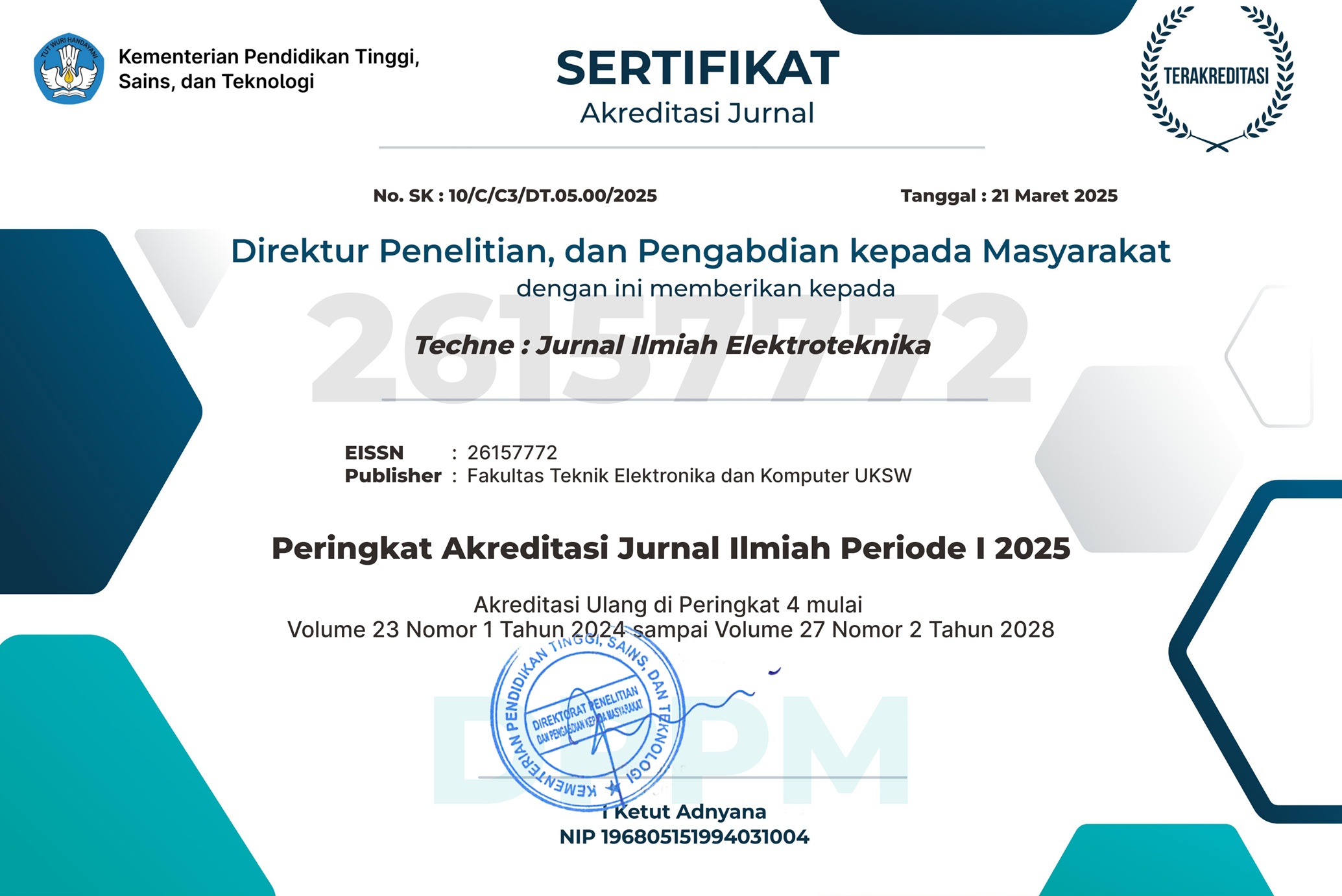LEESOLA: A Locally Made Energy Efficient Solar Tracking System for Home Use
DOI:
https://doi.org/10.31358/techne.v23i1.413Keywords:
solar tracking, energy harvesting, photovoltaic, PV panels, lightAbstract
A solar tracking system is used to orient solar reflectors, photovoltaic panels, and other solar energy harvesting equipment toward the sun mainly to maximize energy output. The LEESOLA system offers an optimized way to increase the amount of energy produced by exposing the harvesting equipment to the sun’s rays. This project is a crucial step towards a more sustainable future and reducing the reliance of humans on traditional energy sources. The system architecture of the LEESOLA solar tracker consists of a microcontroller-based control unit, an ultra-violet (UV) sensor module, motor drivers and PV panels. The UV sensor module detects the location of the sun and sends signals to the control unit. The control unit then passes signals to the motor drivers to introduce a change in the position of the solar panels. The control unit makes use of a suitable algorithm for keeping track of the location of the sun throughout the day and changes the angle of the PV panels accordingly. The UV sensor module makes use of essential optoelectronic components such as photodiodes or phototransistors to detect the position of the sun accurately. As a measure of eliminating any occurrence of misalignment due to factors such as weather conditions, the system has a built-in feedback mechanism that actively monitors the solar panel’s position and adjusts the motor drivers to correct any misalignment. The proposed system obtained an improvement of about 69.29%, 59.41% and 184.96% mean percentage difference in the measured power readings for morning, afternoon, and evening durations respectively. Therefore, this LEESOLA system provided an all-rounded performance improvement over the limiting static methods.
Downloads
References
A.K. Singh and R.R. Singh, “An Overview of Factors Influencing Solar Power Efficiency and Strategies for Enhancing.” 2021 Innovations in Power and Advanced Computing Technologies (i-PACT), pp: 1-6. 2021. doi: 10.1109/i-PACT52855.2021.9696845.
“Executive summary – renewables 2021 – analysis -IEA.”, [Online]. Available: https://www.iea.org/reports/renewables- 2021/executive - summary.
C. Jamroen, P. Komkum, S. Kohsri, W. Himananto, S. Panupintu, and S. Unkat, “A low-cost dual-axis solar tracking system based on digital logic design: Design and implementation,” Sustainable Energy Technologies and Assessments, vol. 37, 2020, issn: 22131388. doi: 10.1016/j.seta.2019.100618.
A. Karabiber and Y. G ?une ?s, “Single motor and dual axis solar tracking system for micro pv power plants,” Journal of Solar Energy Engineering, pp. 1–22, Jan. 2023, issn: 0199-6231. doi: 10.1115/1.4056739.
U. Mamodiya and N. Tiwari, “Design, implementation performance analysis of solar tracking system on simulink platform,” IOP Conference Series: Materials Science and Engineering, vol. 988, p. 012 118, 1 Dec. 2020, issn:1757-899X. doi: 10.1088/1757-899X/988/1/012118.
N. Kuttybay, A. Saymbetov, S. Mekhilef, et al., “Optimized single-axis schedule solar tracker in different weather conditions,” Energies, 2020, Vol.13, Page 5226, vol. 13, p. 5226, 19 Oct. 2020, issn: 1996-1073. doi: 10.3390/EN13195226.
R. P. Singh, “Effect of single axis solar tracking system on the performance of photovoltaic system: A comparative experimental study,” Turkish Journal of Computer and Mathematics Education (TURCOMAT), vol. 12, pp. 1746–1751, 2 Apr. 2021, issn: 1309-4653. doi: 10.17762/TURCOMAT.V12I2. 1511.
Rizk and Y. Chaiko, “Solar tracking system: More efficient use of solar panels,” International Journal of Electrical and Computer Engineering, Vol. 2, pp. 784–786, 5 May 2018. doi: 10.5281/ZENODO.1075038.
Y. Zhu, J. Liu, and X. Yang, “Design and performance analysis of a solar tracking system with a novel single-axis tracking structure to maximize energy collection,” Applied Energy, vol. 264, p. 114 647, Apr. 2020, issn: 0306-2619. doi: 10.1016/J.APENERGY.2020.114647.
I.E. Nwankwo, E.C. Anyanwu, and O.A. Osanaiye, “Development of a Smart Solar Tracking System for Energy Harvesting Applications”. IEEE Access, 9, 12445-12456. 2021. doi: 10.1109/ACCESS.2021.3051211
B. E. Tarazona-Romero, J. S. Carre ?no-Rodriguez, A. D. Quintero-Ruiz, C. L. Sandoval-Rodriguez, and O. Lenguerke-P ?ereza, “Evaluation of solar tracking systems applied to small-scale photovoltaic systems: A review” IOP Conference Series: Materials Science and Engineering, vol. 1253, p. 012 002,1 Sep. 2022, issn: 1757-899X. doi: 10.1088/1757-899X/1253/1/012002.
A. Diaz, R. Garrido, and J. J. Soto-Bernal, “A filtered sun sensor for solar tracking in hcpv and csp systems,” IEEE Sensors Journal, vol. 19, pp. 917925, 3 Feb. 2019, issn: 1530437X. doi: 10.1109/JSEN.2018.2879460.
P. Munanga, S. Chinguwa, and W. R. Nyemba, “Design for manufacture and assembly of an intelligent single axis solar tracking system,” Procedia CIRP, vol. 91, pp. 571–576, Jan. 2020, issn: 2212-8271. doi: 10.1016/J.PROCIR.2020.03.109.
Joysankha Ghosh and Pabak Das. “Automatic Solar Tracking System.” B.S. Thesis, Department of Applied Electronics and Instrumentation Engineering, RCC Institute of Information Technology, Beliaghata, Kolkata,May, 2019. [Online]. Available: https://rcciit.org/students_projects/projects/aeie/2019/GR2.pdf
G. Reeseman, “Overcoming LDR saturation in a sun tracking solar panel system,” 2020. [Online]. Available: https://mospace.umsystem.edu/xmlui/bitstream / handle / 10355 / 74780 / Pages % 5C % 20from % 5C % 20Honors _Lucerna14_Reesman.pdf?sequence=1
N. AL-Rousan, N. A. M. Isa, and M. K. M. Desa, “Efficient single and dual axis solar tracking system controllers based on adaptive neural fuzzy inference system,” Journal of King Saud University - Engineering Sciences, vol. 32, pp. 459–469, 7 Nov. 2020, issn: 1018-3639. doi: 10. 1016 / J. JKSUES.2020.04.004.
A. A. Shehu, N. Abubakar, B.S. Hamza, and I.G. Sa‘idu, “Design and Construction of a Single Axis Solar Tracker.” Global Scientific Journals, vol. 10, issue 3, March 2022. issn: 2320-9186
Hussain S. Akbar1, Muayyad N. Fathallah, Ozlim O. Raoof, “Efficient Single Axis Sun Tracker Design for Photovoltaic System Applications.” IOSR Journal of Applied Physics (IOSR-JAP), vol. 9, no. 2 Ver. II (Mar. – Apr. 2017), pp: 53-60. e-ISSN: 2278-4861.
Circuit Digest (2022), Arduino Uno hardware description [Online image] [Accessed on 15th July 2023] https://circuitdigest.com/sites/default/files/field/image/Arduino-UNO-Description.png
Usinainfo (2022), GUVA-S12D Keyes UV Sensor. [Online image] [Accessed on 12th June 2023] https://www.usinainfo.com.br/1028166-thickbox_default/sensor-uv-ultravioleta-guva-s12sd-keyes.jpg
Downloads
Published
How to Cite
Issue
Section
License
Copyright (c) 2024 Benjamin Kommey, Elvis Tamakloe, Agbesi Jerry, Darkwa Wassem, Normenyo Gershon Elikem

This work is licensed under a Creative Commons Attribution-NonCommercial-ShareAlike 4.0 International License.








